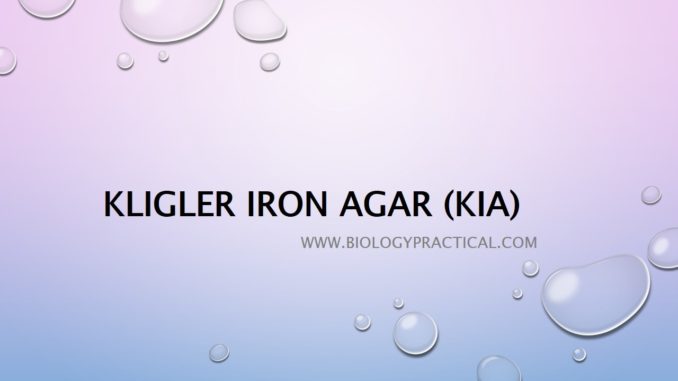
Kligler Iron Agar (KIA)
- Kligler iron agar (KIA) is a differential slope medium used to assist in the identification of salmonella, Shigella and other energetic bacteria.
- KIA reactions are based on the fermentation of lactose and glucose (dextrose) and the production of hydrogen sulphiide.
Composition of KIA:
- KIA is best and most economically prepared from the dehydrated medium which is available commercially.
- Lab-lemco powder……………………………………..3.0 gm/ltr
- Peptone………………………………………………………20.0 gm/ltr
- Sodium chloride………………………………………….5.0 gm/ltr
- Yeast extract……………………………………………….3.0 gm/ltr
- Lactose………………………………………………………10.0 gm/ltr
- Dextrose…………………………………………………..1.0 gm/ltr
- Ferric citrate…………………………………………….0.3 gm/ltr
- Sodium thiosulphate…………………………………0.3 gm/ltr
- Phenol red ……………………………………………..0.05 gm/ltr
- Agar………………………………………………………..12.0 gm/ltr
Preparation of KIA:
- The medium is used at a concentration of 5.5 grams in every 100 ml of distilled water.
- Prepare as instructed by the manufacturer.
- When cooled to 50-55°C, mix well and dispense in 6 ml amounts in large size tubes.
- Sterilize by autoclaving (with caps loosened) at121°Cfor 15 minutes.
- Allow the medium to solidify in a sloped position to give a butt about 25 mm deep and a slope about 25 mm long.
- Date the medium and give it a batch number.
Quality control
- pH of medium: this should be within the range of pH 7.2-7.6 at room temperature.
- Store in a cool dark place or at 2-8°C.
Use of KIA:
- Used to differentiate Salmonella, Shigella and other enteria bacteria on the basis ofglucose and lactose fermentation and production of H2S gas.
- *Use a straight wire to inoculate KIA medium, first stabbing the butt and then streaking the slope in a zig-zag pattern. After inoculation make sure the tube tops are left loose.
Result interpretation of triple sugar iron test on KIA
- A yellow butt (acid production) and red pink slope indicate the fermentation of glucose only. The slope is pink red due to a reverse ion of the acid reaction under aerobic conditions. This reaction is seen with Salmonella and Shigella species and other enteric pathogens.
- Cracks and bubbles in the medium indicate gas production from glucose fermentation. Gas is produced by Salmonella Paratyphi and some faecal commensals.
- A yellow slope and a yellow butt indicate the fermentation of lactose and possibly glucose. This occurs with E. coli and other enterobacteria.
- A red pink slope and butt indicate no fermentation of glucose or lactose. This is seen with the most strains of Pseudomonas aeruginosa.
- Blackening along the stab line or throughout the medium indicates hydrogen sulphide (H2S) production.
